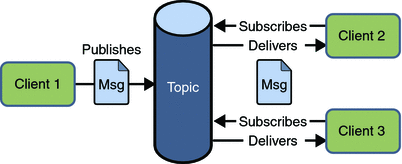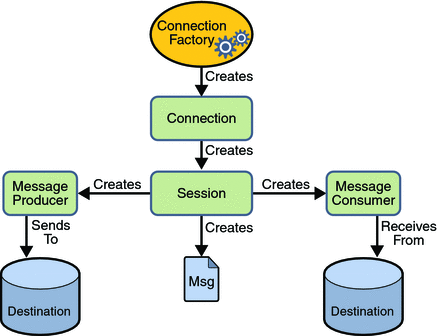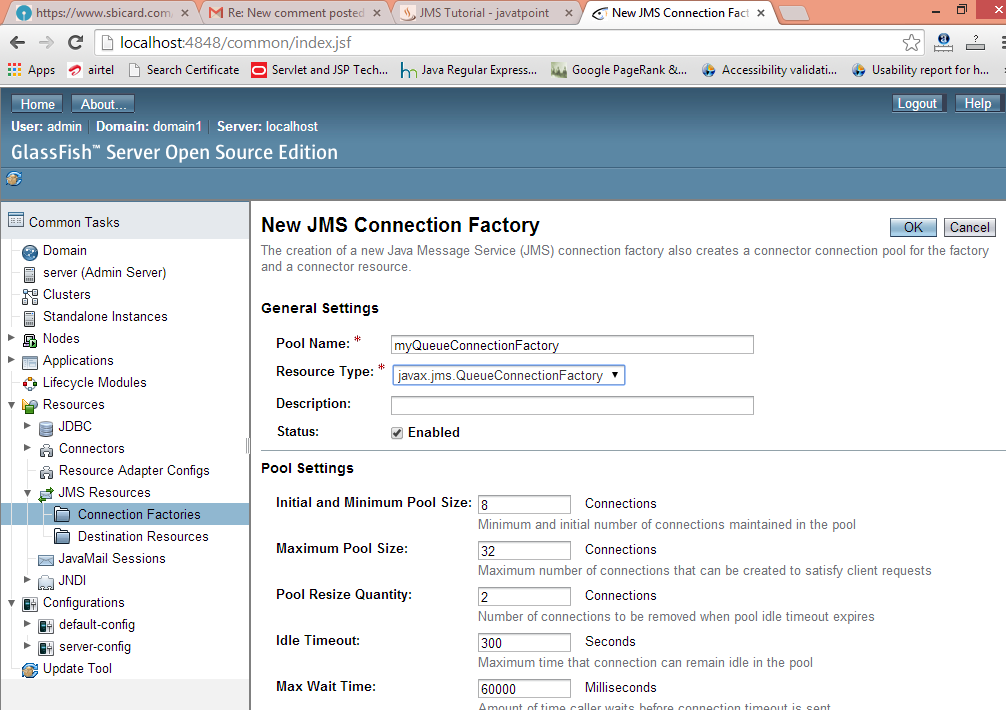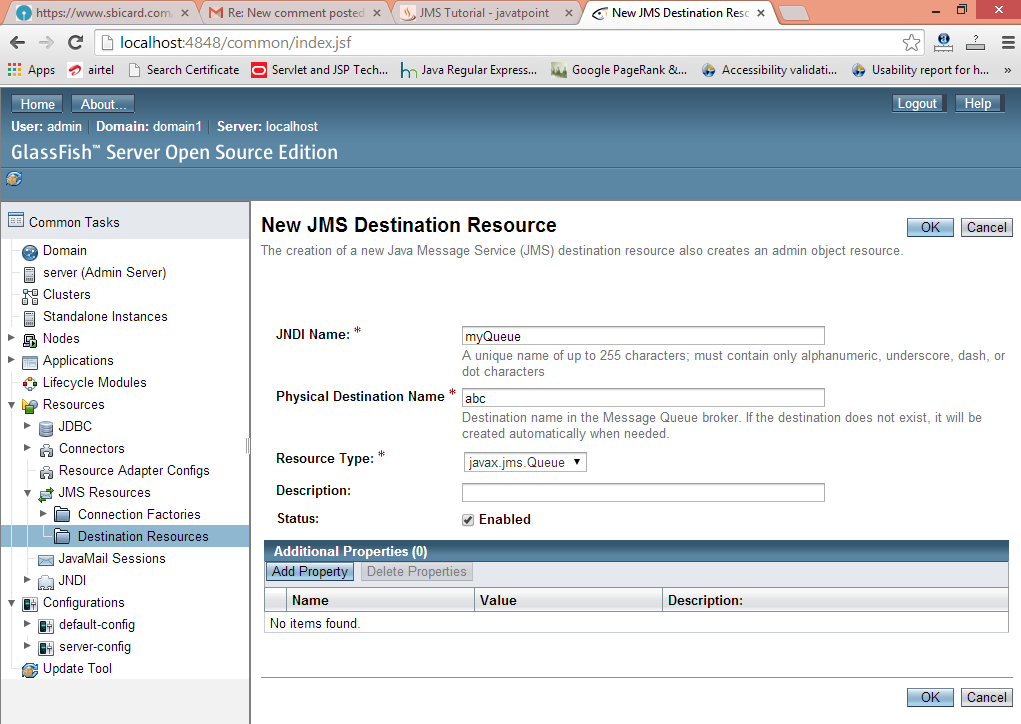JMS Tutorial
JMS (Java Message Service) is an API that provides the facility to create, send and read messages. It provides loosely coupled, reliable and asynchronous communication.
JMS is also known as a messaging service.
Understanding Messaging
Messaging is a technique to communicate applications or software components.
JMS is mainly used to send and receive message from one application to another.
Requirement of JMS
Generally, user sends message to application. But, if we want to send message from one application to another, we need to use JMS API.
Consider a scenario, one application A is running in INDIA and another application B is running in USA. To send message from A application to B, we need to use JMS.
Advantage of JMS
1) Asynchronous: To receive the message, client is not required to send request. Message will arrive automatically to the client.
2) Reliable: It provides assurance that message is delivered.
Messaging Domains
There are two types of messaging domains in JMS.
- Point-to-Point Messaging Domain
- Publisher/Subscriber Messaging Domain
1) Point-to-Point (PTP) Messaging Domain
In PTP model, one message is delivered to one receiver only. Here, Queue is used as a message oriented middleware (MOM).
The Queue is responsible to hold the message until receiver is ready.
In PTP model, there is no timing dependency between sender and receiver.

2) Publisher/Subscriber (Pub/Sub) Messaging Domain
In Pub/Sub model, one message is delivered to all the subscribers. It is like broadcasting. Here, Topic is used as a message oriented middleware that is responsible to hold and deliver messages.
In PTP model, there is timing dependency between publisher and subscriber.

JMS Programming Model

JMS Queue Example
To develop JMS queue example, you need to install any application server. Here, we are using glassfish3 server where we are creating two JNDI.
- Create connection factory named myQueueConnectionFactory
- Create destination resource named myQueue
- Important classes are InitialContent, QueueConnectionFactory, QueueConnection, QueueSession, Queue, QueueSender, TextMessage, QueueReceiver, MessageListener
After creating JNDI, create server and receiver application. You need to run server and receiver in different console. Here, we are using eclipse IDE, it is opened in different console by default.
1) Create connection factory and destination resource
Open server admin console by the URL http://localhost:4848
Login with the username and password.
Click on the JMS Resource -> Connection Factories -> New, now write the pool name and select the Resource Type as QueueConnectionFactory then click on ok button.

Click on the JMS Resource -> Destination Resources -> New, now write the JNDI name and physical destination name then click on ok button.

2) Create sender and receiver application
Let's see the Sender and Receiver code. Note that Receiver is attached with listener which will be invoked when user sends message.
File: MySender.java
- import java.io.BufferedReader;
- import java.io.InputStreamReader;
- import javax.naming.*;
- import javax.jms.*;
-
- public class MySender {
- public static void main(String[] args) {
- try {
-
- InitialContext ctx=new InitialContext();
- QueueConnectionFactory f=(QueueConnectionFactory)ctx.lookup("myQueueConnectionFactory");
- QueueConnection con=f.createQueueConnection();
- con.start();
-
- QueueSession ses=con.createQueueSession(false, Session.AUTO_ACKNOWLEDGE);
-
- Queue t=(Queue)ctx.lookup("myQueue");
-
- QueueSender sender=ses.createSender(t);
-
- TextMessage msg=ses.createTextMessage();
-
- BufferedReader b=new BufferedReader(new InputStreamReader(System.in));
- while(true) {
- System.out.println("Enter Msg, end to terminate:");
- String s=b.readLine();
- if (s.equals("end"))
- break;
- msg.setText(s);
-
- sender.send(msg);
- System.out.println("Message successfully sent.");
- }
-
- con.close();
- }catch(Exception e){System.out.println(e);}
- }
- }
File: MyReceiver.java
- import javax.jms.*;
- import javax.naming.InitialContext;
-
- public class MyReceiver {
- public static void main(String[] args) {
- try{
-
- InitialContext ctx=new InitialContext();
- QueueConnectionFactory f=(QueueConnectionFactory)ctx.lookup("myQueueConnectionFactory");
- QueueConnection con=f.createQueueConnection();
- con.start();
-
- QueueSession ses=con.createQueueSession(false, Session.AUTO_ACKNOWLEDGE);
-
- Queue t=(Queue)ctx.lookup("myQueue");
-
- QueueReceiver receiver=ses.createReceiver(t);
-
- MyListener listener=new MyListener();
-
- receiver.setMessageListener(listener);
- System.out.println("Receiver1 is ready, waiting for messages...");
- System.out.println("press Ctrl+c to shutdown...");
- while(true){
- Thread.sleep(1000);
- }
- }catch(Exception e){System.out.println(e);}
- }
- }
File: MyListener.java
- import javax.jms.*;
- public class MyListener implements MessageListener {
- public void onMessage(Message m) {
- try{
- TextMessage msg=(TextMessage)m;
- System.out.println("following message is received:"+msg.getText());
- }catch(JMSException e){System.out.println(e);}
- }
- }
Run the Receiver class first then Sender class.
JMS Topic Example
It is same as JMS Queue, but you need to change Queue to Topic, Sender to Publisher and Receiver to Subscriber.
You need to create 2 JNDI named myTopicConnectionFactory and myTopic.
1. Important classes are InitialContext, TopicConnectionFactory, TopicConnection, TopicSession, Topic, TopicPublisher, TextMessage, TopicSubscriber, MessageListener
File: MySender.java
- import java.io.BufferedReader;
- import java.io.InputStreamReader;
- import javax.naming.*;
- import javax.jms.*;
-
- public class MySender {
- public static void main(String[] args) {
- try {
-
- InitialContext ctx=new InitialContext();
- TopicConnectionFactory f=(TopicConnectionFactory)ctx.lookup("myTopicConnectionFactory");
- TopicConnection con=f.createTopicConnection();
- con.start();
-
- TopicSession ses=con.createTopicSession(false, Session.AUTO_ACKNOWLEDGE);
-
- Topic t=(Topic)ctx.lookup("myTopic");
-
- TopicPublisher publisher=ses.createPublisher(t);
-
- TextMessage msg=ses.createTextMessage();
-
- BufferedReader b=new BufferedReader(new InputStreamReader(System.in));
- while(true) {
- System.out.println("Enter Msg, end to terminate:");
- String s=b.readLine();
- if (s.equals("end"))
- break;
- msg.setText(s);
-
- publisher.publish(msg);
- System.out.println("Message successfully sent.");
- }
-
- con.close();
- }catch(Exception e){System.out.println(e);}
- }
- }
File: MyReceiver.java
- import javax.jms.*;
- import javax.naming.InitialContext;
-
- public class MyReceiver {
- public static void main(String[] args) {
- try {
-
- InitialContext ctx=new InitialContext();
- TopicConnectionFactory f=(TopicConnectionFactory)ctx.lookup("myTopicConnectionFactory");
- TopicConnection con=f.createTopicConnection();
- con.start();
-
- TopicSession ses=con.createTopicSession(false, Session.AUTO_ACKNOWLEDGE);
-
- Topic t=(Topic)ctx.lookup("myTopic");
-
- TopicSubscriber receiver=ses.createSubscriber(t);
-
- MyListener listener=new MyListener();
-
- receiver.setMessageListener(listener);
- System.out.println("Subscriber1 is ready, waiting for messages...");
- System.out.println("press Ctrl+c to shutdown...");
- while(true){
- Thread.sleep(1000);
- }
- }catch(Exception e){System.out.println(e);}
- }
- }
File: MyListener.java
- import javax.jms.*;
- public class MyListener implements MessageListener {
-
- public void onMessage(Message m) {
- try{
- TextMessage msg=(TextMessage)m;
- System.out.println("following message is received:"+msg.getText());
- }catch(JMSException e){System.out.println(e);}
- }
- }






Comments
Post a Comment